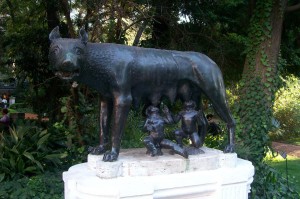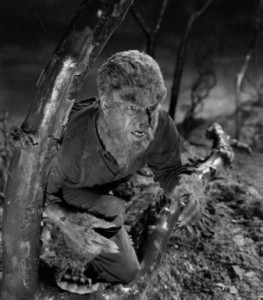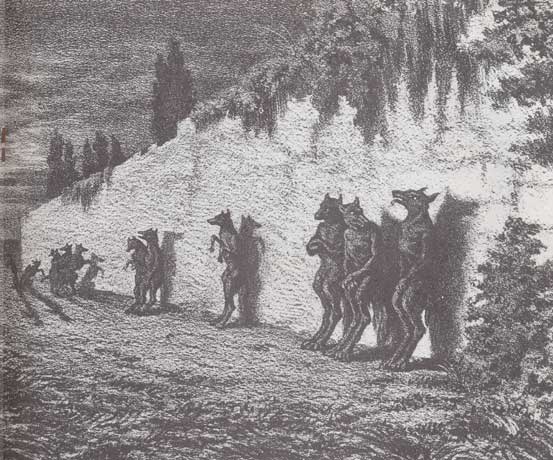Recently, a fellow Twitter user, @LilMissCoyote, asked me my opinion on “the ‘werewolf’ as a spiritually distinct entity from a wolf”. I gave her a quick answer, but I wanted to go into more detail now that I’m not limited to 160 characters at a time.
A werewolf, of course, is a human being who turns into a wolf, often during the full moon, though some werewolves are thought to have more control over the shift from one form to another. While the werewolf is best known from European mythologies, wolf and other shapechangers are spoken of worldwide. They are on the threshold between humanity and the rest of nature; moreover, they embody that liminal space. That is the first part of what makes Werewolf different from Wolf. Gray Wolf is its own being. While all totems can act as bridges between their species and humans, they are still, ultimately themselves. Gray Wolf is not human any more than we are wolves ourselves. But Werewolf is some of both.
The concept of the werewolf has its roots in the differentiation between humans, and all other nature. Once, we were just another animal in the landscape, struggling with other creatures for food, shelter, and safety. At some point we gained a certain awareness of ourselves as a species, and particularly what made us unique among animals. We noticed our unique ways of communication and the advanced tools we created and used. Eventually, we got this idea that these things made us not only special, but separate from other animals and the rest of nature. Some even considered us to be superior to everything else, somehow chosen by a higher power or made in the image of the Divine. We ceased to simply be “the People” among “the Ravens” and “the Tapirs” and “the White Oaks”, and lorded ourselves over the lot.
 So began our supposed separation from the rest of nature. So began the birth of the werewolf.
So began our supposed separation from the rest of nature. So began the birth of the werewolf.
Wolves, you see, aren’t that different from us in personality. We’re both social and have something of a hierarchy in our family-based groups. Once we humans came down from the trees, ate more meat, and headed north, we discovered that we could learn a lot from our lupine neighbors, and in almost every culture that shares space with wolves, these four-legged creatures have featured prominently in our mythologies. They are charismatic megafauna, big and impressive and noticeable. And even today we share space with their descendants, domestic dogs who are our closest non-human companions.
Wolves, then, became our symbol of the rest of nature, and the werewolf the bridge between that and us. How a given community viewed werewolves closely reflects their feelings on nature as a whole; benevolent shapeshifters reflect a more respectable and close-by natural world, while vicious, terrifying monsters often herald a fear of what lies beyond the light of the campfire. In Europe, particularly as Christianity took hold, werewolves and their wolf kin alike were seen as symbols of evil and desolation, and wolves were slaughtered mercilessly to “tame the land”.
Today, all species of wolves are endangered to one degree or another–those, of course, that haven’t been driven extinct already. And more would be extinct, too, had we not had a shift in our own consciousness, particularly those of us in Western countries where the most damage was done. Sometime in the middle of the twentieth century, as the modern environmental movement began to coalesce into more than a basic appreciation for nature, there came scientists and others who spoke up for wolves. Their narratives were not of bloodthirsty killers and two hundred pound monsters lurking in the trees, but of intelligent, family-oriented animals just as fragile and vulnerable to the challenges of the world as the rest of us. They awakened more and more people to the reality that we were more of a danger to the wolves than they were to us–and we were so close to killing them all.
 That change caught up to werewolves, too. Once a mainstay of horror fiction (and still keeping that throne, thank you very much), werewolves are being seen in a more sympathetic light. They may still be fierce and strong and capable of great destruction, but we get to see their softer, more relatable wolf and human sides–and even the occasional cuddliness, too. We see werewolf families, something Lawrence Talbot could never have dreamed of. We watch them muddle through dating and growing pains of all sorts, balance out a normal human lifestyle with the call of the wild, all to varying degrees of success.
That change caught up to werewolves, too. Once a mainstay of horror fiction (and still keeping that throne, thank you very much), werewolves are being seen in a more sympathetic light. They may still be fierce and strong and capable of great destruction, but we get to see their softer, more relatable wolf and human sides–and even the occasional cuddliness, too. We see werewolf families, something Lawrence Talbot could never have dreamed of. We watch them muddle through dating and growing pains of all sorts, balance out a normal human lifestyle with the call of the wild, all to varying degrees of success.
And that’s how we see nature. No longer is nature something harmful to be tamed and turned to our service. Now we accept it as it is, value it for itself, appreciate it in all its blood and glory. We still allow it to have its fangs, but we no longer assume those fangs should not exist because they’re dangerous. And we see the need to preserve nature, kind or harsh, not just for ourselves, but for everything on Earth.
This is the primary lesson of Werewolf. Not bloodlust, not being a furry id, but balance, awareness, turning the strict duality into a continuum. Werewolf is the one who reminds us, more than any other, to come home to nature. Werewolf is the answer to the nature/human perceived divide, and the internal conflict we feel over what makes us unique as a species, and what of us weaves into the rest of nature. Werewolf allows us our individual adventures but waits patiently for us in the moonlight to show us our way home.
Note: This blog post first appeared as exclusive content available only to my patrons at Patreon. Want to be the first to see new content before it goes public, along with work in progress pictures, monthly perks, and other neat things? Support me here on Patreon–just $1 a month gets you the sneak peeks!



Thank you for this, and the one on gray wolf. Good reads, the both of them!
You are most welcome, and thank you for your kind words!
I definitely recommend Wolf Children for those who like shapeshifter movies – especially family friendly thought provoking ones. It ranks as one of my top favorite movies I’ve seen this year – its pretty well The Top so far. It covered a lot of what you’ve mentioned here – which was a very excellent read by the way 🙂
It’s high on my to-watch list–I keep seeing gif sets and the like on Tumblr, and I’m intrigued!
I love the newer version of red riding Hood movie 🙂 very romantic ending.